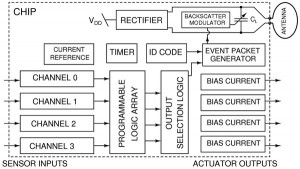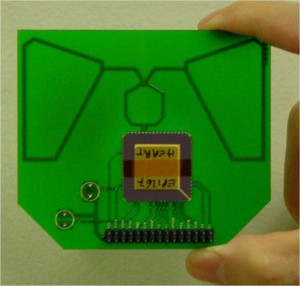A Low-power, Battery-free Tag for Body-sensor Networks
We have developed a low-power, battery-free tag for use in pervasive sensing applications such as wearable patient-monitoring systems or body-sensor networks. The tag consists of a custom integrated circuit, an antenna for RF energy harvesting, and several sensors for monitoring important physiological parameters and generating alarms when necessary. The chip contains four independently-programmable channels that generate asynchronous spikes when biomedical signals cross a programmable threshold voltage. Spike duration and maximum spiking rate are also programmable. Spikes on different channels can be combined using a programmable logic array (PLA). Each channel can also actuate an external sensor by supplying DC current. When not powering external sensors, the chip consumes only 1.0µW of power. The chip forms the basis for a low-cost, battery-free sensor platform for medical monitoring and alarm generation.
- Figure 1: Block diagram of the low-power patient-monitoring chip. The chip contains four independent channels that can be used to interface to various types of sensors. The outputs of these channels are digital spike signals. These signals can be combined in a flexible way using a Programmable Logic Array (PLA) that can implement a variety of Boolean logic functions.
- Figure 2: A photograph of the experimental 800-MHz prototype. We estimate that the area of the prototype can easily be halved by using a smaller package for the chip and a more optimized antenna. In addition, the pins at the bottom of the prototype were for testing purposes and are not necessary for a final commercial system.

